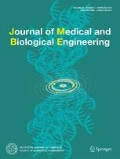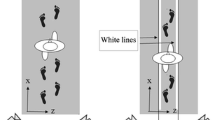Abstract
This study investigates the effect of concussion on the inter-joint coordination of the lower extremities during walking. Gait analyses were performed on 15 young adults who had suffered a concussion and 15 matched controls while walking on level ground with and without a concurrent cognitive task. The continuous relative phase (CRP), derived from phase planes of two adjacent joints, was used to assess the inter-joint coordination. Variability of coordination was assessed using the average value of all standard deviations calculated for each data point over the stance or swing phases from all CRP curves, namely the deviation phase. The results show that subjects who had had a concussion achieved a level of performance on the concurrent cognitive task similar to that of their matched controls, but had altered gait performance. The temporal–spatial gait control and the kinematic control of each individual joint were found to be altered immediately following a concussion. Patterns of the inter-joint coordination were similar to those of normal individuals. However, greater variability of inter-joint coordination patterns was found in swing phase hip–knee coordination. Examination of the inter-joint coordination could explain the observed deviations in gait performance and joint motion of individuals who had suffered a concussion.

Similar content being viewed by others
References
Bazarian, J. J., McClung, J., Shah, M. N., Cheng, Y. T., Flesher, W., & Kraus, J. (2005). Mild traumatic brain injury in the United States, 1998–2000. Brain Injury, 19, 85–91.
Dvorak, J., McCrory, P., Aubry, M., Molloy, M., & Engebretsen, L. (2009). Concussion sans frontières. British Journal of Sports Medicine, 43, i1–i2.
Frencham, K., Fox, A., & Maybery, M. (2005). Neuropsychological studies of mild traumatic brain injury: A meta-analytic review of research since 1995. Journal of Clinical and Experimental Neuropsychology, 27, 334–351.
Slobounov, S., Sebastianelli, W., & Simon, R. (2002). Neurophysiological and behavioral concomitants of mild brain injury in collegiate athletes. Clinical Neurophysiology, 113, 185–193.
Slobounov, S., Tutwiler, R., Sebastianelli, W., & Slobounov, E. (2006). Alteration of postural responses to visual field motion in mild traumatic brain injury. Neurosurgery, 59, 134–139.
van der Naalt, J., van Zomeren, A. H., Sluiter, W. J., & Minderhoud, J. M. (1999). One year outcome in mild to moderate head injury: The predictive value of acute injury characteristics related to complaints and return to work. Journal of Neurology, Neurosurgery and Psychiatry, 66, 207–213.
Emanuelson, I., Holmkvist, E. A., Bjorklund, R., & Stalhammar, D. (2003). Quality of life and post-concussion symptoms in adults after mild traumatic brain injury: A population-based study in western Sweden. Acta Neurologica Scandinavica, 108, 332–338.
Guskiewicz, K. M., Weaver, N. L., Padua, D. A., & Garrett, W. E. (2000). Epidemiology of concussion in collegiate and high school football players. American Journal of Sports Medicine, 28, 643–650.
McCrory, P. R., & Berkovic, S. F. (1998). Second impact syndrome. Neurology, 50, 677–683.
Pugh, K. G., & Lipsitz, L. A. (2002). The microvascular frontal-subcortical syndrome of aging. Neurobiology of Aging, 23, 421–431.
Serrien, D., Ivry, R., & Swinnen, S. (2007). The missing link between action and cognition. Progress in Neurobiology, 82, 95–107.
Parker, T., Osternig, L., Lee, H., Donkelaar, P., & Chou, L. S. (2005). The effect of divided attention on gait stability following concussion. Clinical Biomechanics, 20, 389–395.
Parker, T. M., Osternig, L. R., Van Donkelaar, P., & Chou, L. S. (2006). Gait stability following concussion. Medicine and Science in Sports and Exercise, 38, 1032–1040.
Cantin, J. F., McFadyen, B. J., Doyon, J., Swaine, B., Dumas, D., & Vallée, M. (2007). Can measures of cognitive function predict locomotor behaviour in complex environments following a traumatic brain injury. Brain Injury, 21, 327–334.
Catena, R. D., van Donkelaar, P., & Chou, L. S. (2007). Altered balance control following concussion is better detected with an attention test during gait. Gait Posture, 25, 406–411.
Saunders, J. B. D. M., Inman, V. T., & Eberhart, H. D. (1953). The major determinants in normal and pathological gait. The Journal of bone and Joint Surgery. American Volume, 35, 543–558.
Bernstein, N. A. (1967). The Coordination and regulation of movements. London: Pergamon Press.
Wang, T. M., Yen, H. C., Lu, T. W., Chen, H. L., Chang, C. F., Liu, Y. H., & Tsai, W. C. (2009). Bilateral knee osteoarthritis does not affect inter-joint coordination in older adults with gait deviations during obstacle-crossing. Journal of Biomechanics, 42, 2349–2356.
Yen, H. C., Chen, H. L., Liu, M. W., Liu, H. C., & Lu, T. W. (2009). Age effects on the inter-joint coordination during obstacle-crossing. Journal of Biomechanics, 42, 2501–2506.
American Academy of Neurology. (1997). Practice parameter: the management of concussion in sports (summary statement). Neurology, 48, 581–585.
Bell, R., & Hall, R. C. W. (1977). Mental status examination. American Family Physician, 16, 145–152.
Woltring, H. J. (1986). A Fortran package for generalized, cross-validatory spline smoothing and differentiation. Advanced Engineering Software, 8, 104–113.
Stergiou, N., Jensen, J. L., Bates, B. T., Scholten, S. D., & Tzetzis, G. (2001). A dynamical systems investigation of lower extremity coordination during running over obstacles. Clinical Biomechanics, 16, 213–221.
Peters, B. T., Haddad, J. M., Heiderscheit, B. C., Van Emmerik, R. E. A., & Hamill, J. (2003). Limitations in the use and interpretation of continuous relative phase. Journal of Biomechanics, 36, 271–274.
Kelso, J. A. S., Holt, K. G., Rubin, P., & Kugler, P. N. (1981). Patterns of human interlimb coordination emerge from the properties of non-linear, limit-cycle oscillatory processes-theory and data. Journal of Motor Behavior, 13, 226–261.
Schoner, G., & Kelso, J. A. S. (1988). Dynamic pattern generation in behavioral and neural systems. Science, 239, 1513–1520.
Burgesslimerick, R., Abernethy, B., & Neal, R. J. (1993). Relative phase quantifies interjoint coordination. Journal of Biomechanics, 26, 91–94.
Stergiou, N., Scholten, S. D., Jensen, J. L., & Blanke, D. (2001). Intralimb coordination following obstacle clearance during running: The effect of obstacle height. Gait Posture, 13, 210–220.
Kadaba, M. P., Ramakrishnan, H. K., Wootten, M. E., Gainey, J., Gorton, G., & Cochran, G. V. B. (1989). Repeatability of kinematic, kinetic, and electromyographic data in normal adult gait. Journal of Orthopaedic Research, 7, 849–860.
Ebersbach, G., Dimitrijevic, M. R., & Poewe, W. (1995). Influence of concurrent tasks on gait—a dual-task approach. Perceptual and Motor Skills, 81, 107–113.
Kelso, J. A. S., Schoner, G., Scholz, J. P., & Haken, H. (1987). Phase-locked modes, phase-transitions and component oscillators in biological motion. Physica Scripta, 35, 79–87.
McFadyen, B. J., Cantin, J. F., Swaine, B., Duchesneau, G., Doyon, J., Dumas, D., & Fait, P. (2009). Modality-specific, multitask locomotor deficits persist despite good recovery after a traumatic brain injury. Archives of Physical Medicine and Rehabilitation, 90, 1596–1606.
Author information
Authors and Affiliations
Corresponding author
Rights and permissions
About this article
Cite this article
Chen, HL., Lu, TW. & Chou, LS. Effect of Concussion on Inter-joint Coordination During Divided-Attention Gait. J. Med. Biol. Eng. 35, 28–33 (2015). https://doi.org/10.1007/s40846-015-0002-2
Received:
Accepted:
Published:
Issue Date:
DOI: https://doi.org/10.1007/s40846-015-0002-2




